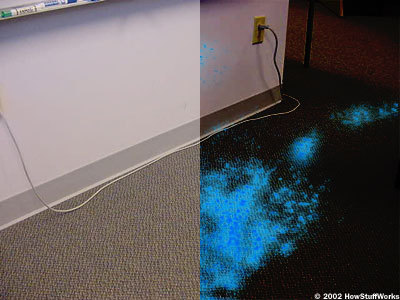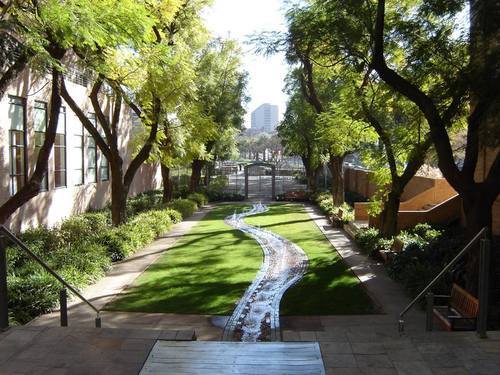28.05.17 // New Week, New Window 💭

28.05.17 // new week, new window 💭
More Posts from Theperpetualscholar and Others


Luminol is a chemical that can be used to show trace amounts of blood by creating a light producing chemical reaction when mixed with hemoglobin.
Luminol powder is mixed into a liquid containing hydrogen peroxide and other chemicals. This mixture will then be sprayed over the area that is being examined.
The reaction of the Luminol spray mixing with the iron in blood will then produce a blue glow that can be seen in a dark room.
Other substances that can accidentally have the same reaction with Luminol are: bleach, urine, faeces & horseradish.
Unfortunately Luminol can destroy other crime scene evidence so it is usually used after other options have been explored.
omg thank you so much for putting rosalind franklin in the dna history post!!
And also:
i think it is morecorrect to say that in 1953 Watson and Crick stole Rosalind’s picture to buildtheir model, and when they published it, of course they didn’t gave her anycredit. I think it is important for people to know that Rosalind Franklindiscovered the antiparallel structure of the DNA molecule, but since herstudies and researches were published after Watson and Crick’s, she didn’t getany recognition until many years later. (Sorry for the long message!)
Hello Nonnies!!
We can’t not talk aboutRosalind Franklin. She is an awesome lady that is slowly getting therecognition she deserves in the scientific community.
(We also went to an allgirls catholic highschool with large emphasis on science, and her name alwayscame up in all of the science classes. It’s pretty hard to forget her name now.We are also going to hijack these asks to give a more in-depth biography forRosalind Franklin.)
Franklin was a giftedX-ray crystallographer. She was a research associate at King’s College Londonin 1951, moved to Birkbeck College in 1953. She died at the early age of 37 dueto ovarian cancer. Really she should have gotten the same Nobel Prize thatWatson, Crick, and Wilkins shared in 1962 for the discovery of the DNA doublehelix, but the Nobel Committee are pricks and don’t award prizes posthumously.
Franklin’s the one tofirst contribute the concept of the two forms of DNA; A-DNA (dried, short andfat), and B-DNA (wet, long and thin). Photo 51 (image from Wikipedia) is thex-ray diffraction pattern developed while at King’s College that leads to thediscovery of DNA double helix structure.

There has been some controversies surrounding the nature ofher work being used by Watson and Crick. Allegations where made that Photo 51was shown to Watson by her colleague Wilkins without Franklin’s permission (badscience ethics here) but we are not sure how true that allegation is. Franklindid not gain much recognition for her contribution originally, all that wasmentioned was a footnote acknowledging that it was based on “general knowledge”of Franklin’s unpublished contribution.
Rosalind Franklin is a good example of sexism in science. She’s not gaining a lot of posthumous recognition for her work. I would also like to think that she’s an awesome role model for a lot of girls pursuing science as a field of study.

Nursing a New Year’s Day hangover? Here’s the chemistry behind it: http://wp.me/s4aPLT-hangover

“Animal blood comes in a rainbow of hues because of the varying chemistry of the molecules it uses to carry oxygen. Humans use hemoglobin, whose iron content imparts a crimson color to our red blood cells. Octopuses, lobsters, and horseshoe crabs use hemocyanin, which has copper instead of iron, and is blue instead of red—that’s why these creatures bleed blue. Other related molecules are responsible for the violet blood of some marine worms, and the green blood of leeches. But the green-blooded lizards use good old hemoglobin. Their red blood cells are, well, red. Their green has a stranger origin: Biliverdin.
They should be dead. Biliverdin can damage DNA, kill cells, and destroy neurons. And yet, the lizards have the highest levels of biliverdin ever seen in an animal. Their blood contains up to 20 times more of it than the highest concentration ever recorded in a human—an amount that proved to be fatal. And yet, not only are the lizards still alive, they’re not even jaundiced. How do they tolerate the chemical? Why did they evolve such high levels of biliverdin in the first place? And why, as Austin’s colleague Zachary Rodriguez has just discovered, did they do so on several occasions?”
Source: TheAtlantic

Important Terms
For approaching Religious and Anthropological Studies:

Cultural Relativism:
“The ability to view the beliefs and customs of other peoples within the context of their own cultures rather than one’s own; or, describing another culture from its own point of view without imposing one’s own cultural values.” Look at what people BELIEVE, not whether or not what they believe is “true.”

Ethnocentrism (the opposite of cultural relativism):
“The tendency to judge the customs of other societies by the standards of one’s own; combines the belief in the superiority of one’s own culture with the practice of judging other cultures by the standards and values of one’s own culture.”
Harnessing ethnocentric ideas when approaching religious and cultural studies will hinder one from truly being able to learn and understand other peoples and their cultures.

A note on Nuclear Fission
When an atom fissions, it releases a teeny tiny amount of energy ( The decay of one atom of uranium-235 releases about 200MeV or about 3*10-11J.). But atoms are quite small. An atom does not make a big explosion when it splits.
To get a big explosion, you need to split lots and lots and lots and lots and lots and lots and lots and lots and lots of them—many, many trillions of them.
Each one releases only a teeny amount of energy, but when you add up the teeny amount of energy from trillions and trillions and trillions of atoms, then you get a big explosion. (The explosion of 1kg of TNT releases 4MJ).

Today marks the birthday of Alfred Nier (1911-1994), a pioneer in the field of mass spectrometry. Here’s a brief mass spectrometry introduction! PDF here: http://wp.me/p4aPLT-1bw
FREE MEDICAL PDFs
Anatomy:
1–> KLM for Gross Anatomy
2–> Snell’s Anatomy
3–> BD Churassia
4–> RJ Last
5–> Grey’s Anatomy
6–> Langman Embryology
7–> KLM for Embryology
8–> BD For General Anatomy
9–> Dissector
10–> Di Fore Histology
11–> Junqueira’s Histology
12–> Netter Atlas of human Aantomy
Folder link–> https://drive.google.com/open?id=0B3WdpdsqpX0LYV9KQ3lxY29FY28
Physiology:
1–> Guyton
2–> Ganong
3–> Sheerwood
4–> Sembulingam
Folder link–> https://drive.google.com/open?id=0B3WdpdsqpX0LdXlCSjdZM214dEE
Biochemistry:
1–> Harper
2–> Lippincott
3–> Chatterjea
4–> Satyanarayan
5–> Stryer
6–> MRS Biochemistry
Folder link–> https://drive.google.com/open?id=0B3WdpdsqpX0Ld0o3WnhCR2VEczg
Pathology:
1–> Big Robins
2–> Medium Robins
3–> Pathoma
4–> Goljan
5–> Harsh Mohan Pathology
6–> Atlas of Histopathology
7–> Levinson
8–> MRS microbiology
9–> Microbiology by Jacquelyn G. Black
10–> Color Atlas of Microbiology
11–> Kaplan Pathology
Folder link–> https://drive.google.com/open?id=0B3WdpdsqpX0LYkRYdjFrTm5MR0U
Pharmacology:
1–> Big Katzung
2–> Mini Katzung
3–> Kaplan Review
4–> Lippincott
5–> Pocket Katzung
6–> Rang and Dale’s Pharmacology
7–> Atlas of Pharmacology
Folder link–> https://drive.google.com/open?id=0B3WdpdsqpX0LMkE1UUVRZGwtTlU
Forensic Medicine:
1–> Simpson’s Forensics
2–> Krishan’s Forensics
3–> Atlas of Autopsy
4–> Atlas of Forensic Medicine
Folder link–> https://drive.google.com/open?id=0B3WdpdsqpX0LQXVwOGoyWnFSV2s
Ophthalmology:
1–> Jogi
2–> Jatoi
3–> Parson’s Textbook of Eye
4–> Kanski
5–> AK Khurana
6–> Atlas of ophthalmology
Folder link–> https://drive.google.com/open?id=0B3WdpdsqpX0LOHc5WVZMdkJjX2M
Otorhinolaryngology:
1–> Dhingra
2–> Logans Turner
3–> Color Atlas of Otorhinolaryngology
4–> Maqbool’s Text Book of ENT
5–> Clinical Methods in ENT by PT Wakode
6–> ENT at a Glance
Folder link–> https://drive.google.com/open?id=0B3WdpdsqpX0LaDY2a0lFNDlfTGc
Community Medicine:
1–> Monica’s Text Book Community Medicine
2–> Mahajan And Gupta Text Book of Community Medicine
3–> Bancroft’s Text Book of Community Medicine
Folder link–> https://drive.google.com/open?id=0B3WdpdsqpX0Lc1RCMml2NjhFNjA
Internal Medicine:
1–> Churchill’s Pocketbook of DD
2–> MTB Step 2 Ck
3–> Davidson Essentials
4–> Davidson Principals and practice
5–> Harrison’s Internal Medicine
6–> Internal Medicine USMLE Nuggets
7–> Internal Medicine on call bt LANGE 8–> Oxfords Specialties
Folder link–>https://drive.google.com/open?id=0B3WdpdsqpX0LeEFJNG5TMlc4eWc
Surgery:
1–> Bailey_love short practice of Surgery
2–> Churchill’s pocketbook of Surgery
3–> Deja Review of surgery
4–> Farquharson’s Textbook of Operative General Surgery
5–> Hamilton Bailey’s Physical Signs
6–> Oxford Handbook of Clinical Surgery
7–> Schwartz’s Principles of Surgery
8–> Macleod’s Clinical Examination
9–> Macleod’s Clinical Diagnosis
Folder link–>https://drive.google.com/open?id=0B3WdpdsqpX0LRFpFSG5hZ1pVWkE
Obstetrics & Gynecology:
1–> Case Discussions in Obstetrics and Gynecology
2–> Deja Review of Obstetrics Gynecology
3–> Obstetrics by Ten Teachers
4–> Gynaecology illustrated
5–> Gynaecology by Ten Teachers
Folder link–>https://drive.google.com/open?id=0B3WdpdsqpX0LMU1LRjFDa1FrbjA
Pediatrics:
1–> Nelson Essentials of Pediatrics
2–> Nelson Complete
3–> Pediatrics Review
Folder link–>https://drive.google.com/open?id=0B3WdpdsqpX0LUkdTQkVuNV92Yzg
I hope this helps everyone, it’s not mine. But has been shared to me and I am sharing this with all of you.
Someone said "Are you really so stupid to think that Africa has the same technological advances as us? If they did they would probably have clean water and not live in houses made of sticks and mud. Get over yourself and stop being so ignorant."..... Below is a tiny collection of images of the Africa they refuse to show you..




ches






I’m sorry you’ve been made to believe that the whole of Africa is poor, I really am..
-
 future-newswire liked this · 1 year ago
future-newswire liked this · 1 year ago -
 m-mihalyiova liked this · 1 year ago
m-mihalyiova liked this · 1 year ago -
 ana-bellla liked this · 3 years ago
ana-bellla liked this · 3 years ago -
 medievalacademia reblogged this · 3 years ago
medievalacademia reblogged this · 3 years ago -
 neptunretro reblogged this · 3 years ago
neptunretro reblogged this · 3 years ago -
 neptunretro liked this · 3 years ago
neptunretro liked this · 3 years ago -
 educarlamirada liked this · 5 years ago
educarlamirada liked this · 5 years ago -
 sommerlyrik reblogged this · 5 years ago
sommerlyrik reblogged this · 5 years ago -
 pigulaxxx3 liked this · 6 years ago
pigulaxxx3 liked this · 6 years ago -
 holebrazil liked this · 6 years ago
holebrazil liked this · 6 years ago -
 yoshitora reblogged this · 6 years ago
yoshitora reblogged this · 6 years ago -
 raleighrufus reblogged this · 6 years ago
raleighrufus reblogged this · 6 years ago -
 raleighrufus liked this · 6 years ago
raleighrufus liked this · 6 years ago -
 sickness666 reblogged this · 6 years ago
sickness666 reblogged this · 6 years ago -
 jerzee55z liked this · 6 years ago
jerzee55z liked this · 6 years ago -
 johnmyersart reblogged this · 6 years ago
johnmyersart reblogged this · 6 years ago -
 acek135 liked this · 6 years ago
acek135 liked this · 6 years ago -
 advent-seph liked this · 6 years ago
advent-seph liked this · 6 years ago -
 mahamahawi liked this · 6 years ago
mahamahawi liked this · 6 years ago -
 seninicin-a89 reblogged this · 6 years ago
seninicin-a89 reblogged this · 6 years ago -
 amira-princess reblogged this · 6 years ago
amira-princess reblogged this · 6 years ago -
 amira-princess liked this · 6 years ago
amira-princess liked this · 6 years ago -
 alyaii reblogged this · 6 years ago
alyaii reblogged this · 6 years ago -
 iabeer-11 reblogged this · 6 years ago
iabeer-11 reblogged this · 6 years ago -
 seham9 reblogged this · 6 years ago
seham9 reblogged this · 6 years ago -
 seham9 liked this · 6 years ago
seham9 liked this · 6 years ago -
 yoshitora liked this · 6 years ago
yoshitora liked this · 6 years ago -
 johnmyersart liked this · 6 years ago
johnmyersart liked this · 6 years ago -
 edieelee reblogged this · 6 years ago
edieelee reblogged this · 6 years ago -
 superno0ova liked this · 6 years ago
superno0ova liked this · 6 years ago -
 curious-and-learning liked this · 6 years ago
curious-and-learning liked this · 6 years ago -
 laila-16 reblogged this · 6 years ago
laila-16 reblogged this · 6 years ago